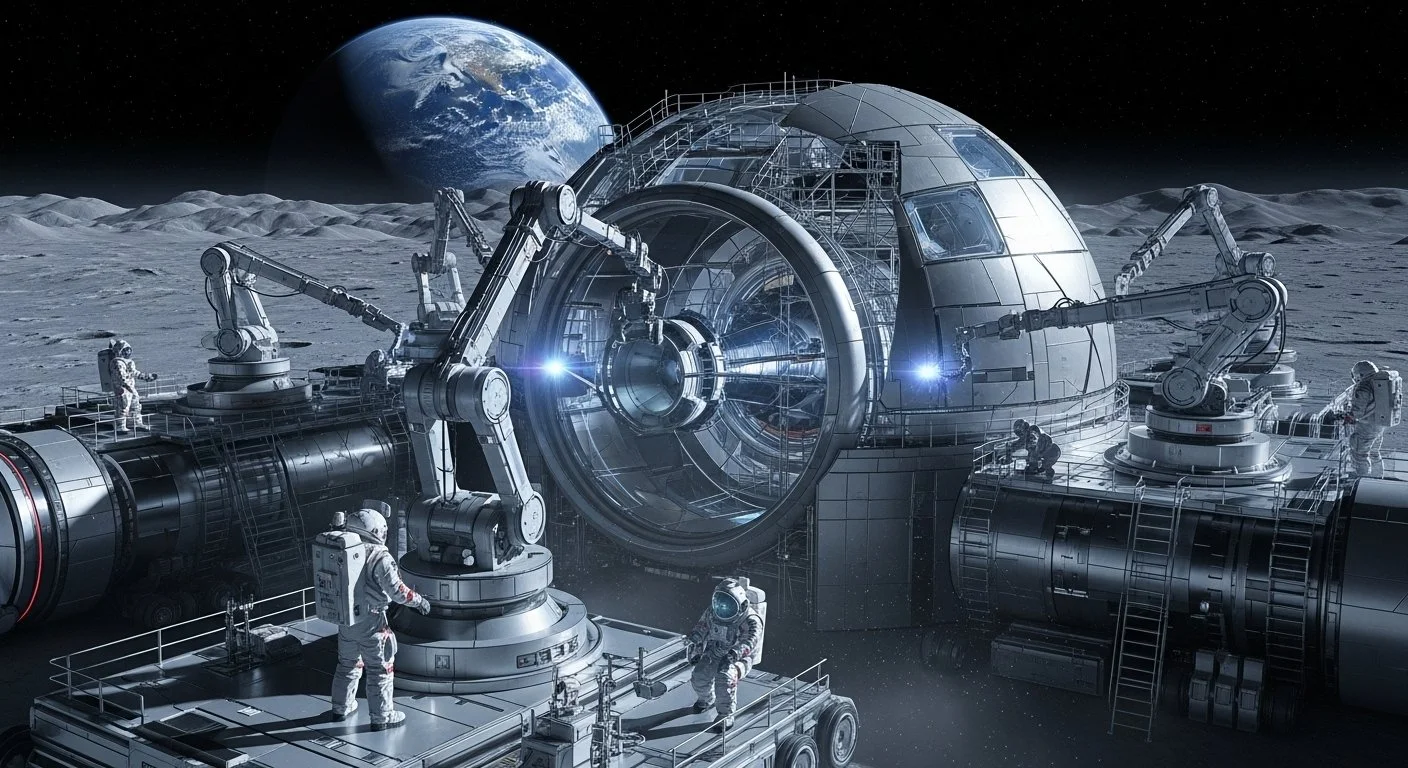How Much Will It Cost to Build a Nuclear Reactor on the Moon?
The race to establish humanity's first lunar nuclear power plant has officially begun, and the numbers are staggering. With NASA fast-tracking plans to deploy a 100-kilowatt nuclear reactor on the Moon by 2030, the estimated total investment reaches $6.2 billion making it one of the most ambitious engineering projects of our generation. As a premier construction company, HKC Construction understands the complexities of large-scale infrastructure projects. While we specialize in terrestrial construction, the engineering principles, project management expertise, and precision manufacturing required for lunar construction share many parallels with the mega-projects we deliver here in Mississauga. The Strategic Imperative: Why Nuclear Power on the Moon?
Acting NASA Administrator Sean Duffy recently announced the accelerated timeline, stating: "We're in a race to the moon, in a race with China to the moon. And to have a base on the moon, we need energy". This isn't just about scientific exploration, it's about establishing territorial advantage in space.
The lunar environment presents unique challenges that make nuclear power essentially mandatory for sustained operations:
· 14.5-day lunar nights make solar power unreliable
· Extreme temperature swings from 200°C day to -130°C night
· Permanently shadowed regions at the lunar poles where water ice exists
· No atmosphere for wind power or chemical combustion
China and Russia have already announced joint plans to deploy their own lunar nuclear reactor by 2035, creating urgency for the American program
Complete Cost Breakdown: Where Every Dollar Goes
Complete cost breakdown for building a nuclear reactor on the Moon: $6.2 billion total investment
Our comprehensive analysis reveals the following detailed cost structure for the lunar nuclear reactor project:
| Category | Cost (Millions) | Percentage | Key Components | |
|---|---|---|---|---|
| Nuclear Reactor Development | $1,500M | 24.4% | Reactor core, uranium fuel assemblies, neutron moderator | |
| Launch Vehicle (Heavy Lift) | $800M | 13.0% | Falcon Heavy/SLS-class rocket for 15+ ton payload | |
| Contingency (20%) | $800M | 13.0% | Risk mitigation for technical challenges and cost overruns | |
| Lunar Lander System | $600M | 9.8% | Specialized lander for precise reactor deployment | |
| Testing & Validation | $400M | 6.5% | Ground testing, space qualification, safety validation | |
| Power Conversion System | $350M | 5.7% | Stirling engines generating 100kW electrical power | |
| Control Systems | $300M | 4.9% | Autonomous operation, sensors, communications | |
| Project Management | $300M | 4.9% | 8-year program coordination and oversight | |
| Manufacturing | $250M | 4.1% | Space-qualified component production | |
| Heat Rejection System | $200M | 3.3% | Space radiators for thermal management | |
| Safety & Licensing | $200M | 3.3% | Nuclear regulatory approval, environmental review | |
| Reactor Shielding | $150M | 2.4% | Radiation protection for equipment and future crew | |
| Operations (5 years) | $150M | 2.4% | Mission control, monitoring, maintenance support | |
| Ground Support Equipment | $100M | 1.6% | Launch processing, mission control systems | |
| Uranium Fuel | $50M | 0.8% | Highly enriched uranium for 10+ years operation | |
| Total Project Cost | $6,150M | 100% | 6.2 Billion in Total |
Timeline Analysis: From Concept to Power Generation
Lunar Nuclear Reactor Project Development Timeline: From Concept to Operation
The lunar nuclear reactor project spans 18.5 years total, with 8.5 years to first power generation:
Phase 1: Design & Development (3 years)
· Reactor engineering and component development
· Safety analysis and environmental impact assessment
· Initial contractor selection and partnerships
· Construction Industry Parallel: Similar to HKC Construction's pre-construction planning phase for major infrastructure projects
Phase 2: Manufacturing (2 years)
· Space-qualified component production
· Quality control and integration testing
· Supply chain coordination across multiple vendors
· HKC Construction Insight: Manufacturing coordination requires the same precision project management we apply to complex builds
Phase 3: Testing & Validation (1.5 years)
· Ground testing under simulated lunar conditions
· Thermal cycling and vibration testing
· Safety validation and performance verification
· Nuclear Regulatory Commission approval process
Phase 4: Launch Preparation (1 year)
· Launch vehicle integration
· Final systems testing
· Regulatory approvals and environmental clearance
· Mission rehearsals and contingency planning
Phase 5: Launch & Deployment (6 months)
· Rocket launch and lunar transit
· Lunar orbit insertion and landing sequence
· Initial system activation and health checks
Phase 6: Commissioning (6 months)
· Full system startup and performance validation
· Integration with lunar surface infrastructure
· Operational procedures validation
Phase 7: Operations (10+ years)
· Autonomous power generation
· Remote monitoring and maintenance
· Continuous 100kW electrical output for lunar base operations
Technical Specifications: Engineering Marvel on the Moon
The proposed lunar nuclear reactor represents cutting-edge Small Modular Reactor (SMR) technology adapted for space deployment:
Power Output & Performance
· Electrical Output: 100 kilowatts continuous
· Thermal Output: Approximately 400 kilowatts thermal
· Operating Lifetime: 10+ years without refueling
· Fuel Type: Low-enriched uranium (LEU) in ceramic form
· Power Conversion: Closed Brayton or Stirling cycle
Physical Specifications
· Total System Mass: Under 15 metric tons (launch constraint)
· Reactor Core Size: Approximately 1.5 meters diameter
· Shielding Requirements: Minimal radiation at 1km distance
· Operating Temperature: 500-800°C reactor core temperature
Operational Capabilities
· Autonomous Operation: No human intervention required
· Remote Monitoring: Real-time telemetry to Earth
· Load Following: Adjustable power output as needed
· Emergency Shutdown: Automatic safety systems
Launch and Transportation Costs: Getting There is Half the Battle
Transportation to the Moon represents a significant cost driver, with current launch costs at $10,800 per kilogram to lunar surface.
Launch Vehicle Options
· SpaceX Falcon Heavy: $97M launch cost, 63.8-ton LEO capacity
· NASA SLS: Higher cost but proven for lunar missions
· SpaceX Starship: Future option with dramatically lower costs
Mass Budget Breakdown
· Reactor System: 8 metric tons
· Lander Structure: 4 metric tons
· Landing Fuel: 3 metric tons
· Total Launch Mass: 15 metric tons (within heavy-lift capacity)
Global Competition: The New Space Race
The lunar nuclear reactor initiative represents more than technological achievement – it's strategic positioning for the 21st century space economy:
China-Russia Partnership
· Joint lunar base planned by 2035
· Nuclear power plant integral to their strategy
· 50 nations invited to participate in their program
U.S. Response Strategy
· Accelerated 2030 deployment timeline
· "Keep-out zone" territorial implications
· Integration with NASA's Artemis program
Economic Implications
· First-mover advantage in lunar resource extraction
· Territorial claims around nuclear installations
· Technology leadership in space nuclear power
Materials and Resource Requirements
Critical Materials Needed
· Highly Enriched Uranium: 200-500 kg for initial fuel load
· Beryllium: For neutron reflection and moderation
· Stainless Steel: Radiation-resistant reactor vessel
· Tungsten: High-temperature shielding material
· Rare Earth Elements: For power conversion systems
Manufacturing Challenges
· Space-qualified components: Every part must survive launch and 10-year operation
· Quality control: Zero-defect manufacturing requirements
· Supply chain security: Critical materials from limited suppliers
· Testing requirements: Extensive validation under simulated conditions
At HKC Construction, we understand the critical importance of materials sourcing and quality control and principles that apply whether building bridges in Missouri or reactors on the Moon.
Regulatory and Safety Framework
Nuclear Regulatory Oversight
· Nuclear Regulatory Commission (NRC): Primary safety authority
· Department of Energy: Technical development oversight
· NASA: Space systems integration and operations
· Environmental Impact Assessment: Required despite off-world deployment
International Space Law Compliance
· Outer Space Treaty (1967): Peaceful use requirements
· Moon Agreement: Resource extraction protocols
· Nuclear Safety Guidelines: UN Office for Outer Space Affairs standards
Safety Considerations
· Launch Safety: Reactor launched "cold" (non-operational)
· Radiation Protection: Minimal exposure at operational distances
· Fail-Safe Design: Multiple redundant safety systems
· Emergency Procedures: Remote shutdown capabilities
Economic Impact and Return on Investment
Direct Economic Benefits
· Technology Development: Advances in SMR technology benefit terrestrial applications
· Job Creation: Thousands of high skilled positions across multiple states
· Industrial Base: Strengthens U.S. nuclear manufacturing capability
· Export Potential: Technology leadership in global space nuclear market
Strategic Value
· Resource Access: Enables lunar mining of Helium-3 and rare metals
· Scientific Discovery: Powers long-duration research missions
· National Security: Establishes U.S. presence in strategically important lunar locations
· Technology Spin-offs: Innovations applicable to terrestrial energy systems
Cost-Benefit Analysis
· $6.2 billion investment enables decades of lunar operations
· Payback through: Technology licensing, resource extraction, strategic advantage
· Comparison: Less than 7% of the total $93 billion Artemis program budget
HKC Construction
🔸
HKC Construction 🔸
A $6.2 Billion Investment in Humanity's Future
The lunar nuclear reactor project represents more than an engineering challenge, it's humanity's next great leap toward becoming a multi-planetary species. At $6.2 billion total cost and an 8.5-year development timeline, this investment will establish American leadership in the emerging space economy while demonstrating technologies essential for Mars exploration and beyond.
For construction professionals like the team at HKC Construction, this project showcases the same principles of excellence, precision, and safety that drive successful infrastructure projects here on Earth. Whether building bridges in Ontario or reactors on the Moon, the fundamentals remain the same: exceptional planning, rigorous execution, and unwavering commitment to quality.
The race to the Moon has begun, and nuclear power will light the way. With China and Russia targeting 2035 for their lunar reactor, America's 2030 timeline represents both challenge and opportunity. Success will require the same dedication to excellence that HKC Construction brings to every project because in space, as in construction, there's no room for compromise.
Ready to tackle your next big project?
While HKC Construction may not be building on the Moon just yet, we bring the same commitment to excellence and precision to every construction project in Missouri. Contact us today to see how our expertise can power your next development.
Citations:
2. https://www.reddit.com/r/fusion/comments/1kq9emh/mining_lunar_he3_for_nuclear_reactors/
4. https://www.cnn.com/2025/08/05/politics/moon-nuclear-reactor-us-nasa
5. https://www.space.com/nasa-moon-nuclear-fission-reactor
6. https://en.wikipedia.org/wiki/Nuclear_power_in_space
7. https://www.msnbc.com/opinion/msnbc-opinion/sean-duffy-nuclear-moon-nasa-space-reactors-rcna223194
11. https://www.barrons.com/articles/nasa-nuclear-reactor-moon-bwx-stock-price-1d697ac0
12. https://www.nasa.gov/space-technology-mission-directorate/tdm/space-nuclear-propulsion/
13. https://bigthink.com/starts-with-a-bang/nuclear-reactor-moon-nasa/
15. https://www.bbc.com/future/article/20240417-the-nuclear-reactors-that-could-power-moon-bases
16. https://www.nytimes.com/2025/08/04/science/nasa-moon-nuclear-reactor.html
18. https://x-energy.com/why/nuclear-and-space/lunar-surface-power
19. https://www.nytimes.com/2025/08/06/science/nasa-nuclear-reactor-moon.html
20. https://www.scientificamerican.com/article/nasa-boosts-plans-for-nuclear-reactor-on-the-moon/












